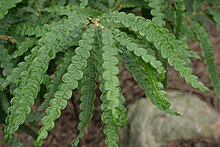Taxonomy
The living species was first described, as Liquidambar peregrina, by Carl Linnaeus in 1753, in the second volume of Species Plantarum . Further on in the same volume, he described Myrica aspleniifolia as a different species (with the epithet spelt asplenifolia). In 1763, he changed his mind concerning Myrica aspleniifolia, and it became Liquidambar aspleniifolia, and so in the same genus as Liquidambar peregrina. [3]
In 1789, Charles Louis L'Héritier placed Linnaeus's original Myrica aspleniifolia in his new genus Comptonia. [4] The genus is named in honor of Rev. Henry Compton (1632-1713), bishop of Oxford.
In 1894, John M. Coulter transferred Linnaeus's Liquidambar peregrina to Comptonia, and treated Linnaeus's Myrica aspleniifolia as a synonym. [3] Comptonia peregrina is now the only extant (living) species in the genus. [1]
Comptonia is categorized as an Actinorhizal plant - an angiosperm characterized by their ability to form a symbiosis with the nitrogen fixing actinomycetota Frankia. This association leads to the formation of nitrogen-fixing root nodules. [5]
This page is based on this
Wikipedia article Text is available under the
CC BY-SA 4.0 license; additional terms may apply.
Images, videos and audio are available under their respective licenses.

